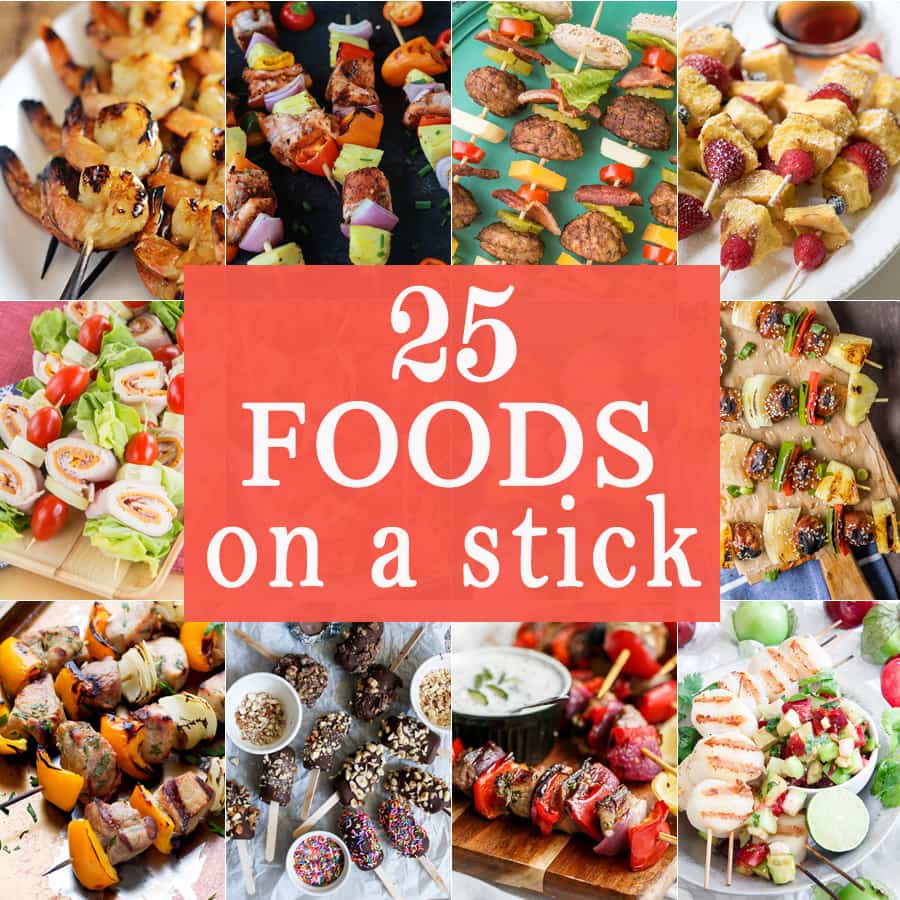Foods on a stick embark on a culinary adventure that traverses cultures and continents, tantalizing taste buds with an array of flavors and textures. From the bustling streets of Southeast Asia to the vibrant markets of the Middle East, this delectable treat has captivated hearts and palates alike, weaving a rich tapestry of culinary traditions.
Prepare to be skewered by the sheer diversity of foods on a stick, as we delve into their historical origins, explore their regional variations, and uncover the secrets behind their irresistible charm. Let the sizzling aromas and vibrant colors transport you to a world where food becomes an art form, impaled on a stick for your gustatory pleasure.
Cultural Significance of Foods on a Stick

Foods on a stick have a long and diverse history, with origins in various cultures worldwide. These culinary creations have played a significant role in shaping culinary traditions and have become an integral part of cultural identities.
In ancient Greece, skewers were used to cook meat over open flames, giving rise to the iconic souvlaki. In the Middle East, shish kebabs emerged as a popular street food, reflecting the region’s nomadic heritage. In Asia, satay, a dish of grilled meat on skewers, became a beloved delicacy in Southeast Asian countries.
Examples of Traditional Foods on a Stick
- Souvlaki (Greece):Grilled meat skewers, often marinated in olive oil, lemon juice, and herbs.
- Shish Kebab (Middle East):Marinated meat or vegetables grilled on skewers.
- Satay (Southeast Asia):Grilled meat or tofu on bamboo skewers, served with a spicy peanut sauce.
- Dango (Japan):Sweet rice balls on skewers, often glazed or filled with various flavors.
- Corn Dog (United States):A hot dog on a stick, dipped in cornmeal batter and deep-fried.
Types and Varieties of Foods on a Stick

Foods on a stick come in a vast array of types and varieties, each with its unique flavors, textures, and cooking methods. From succulent meats to crisp vegetables and refreshing fruits, the possibilities are endless.
The following table categorizes different types of foods on a stick based on their primary ingredient:
| Ingredient | Examples | Unique Flavors and Textures | Cooking Methods |
|---|---|---|---|
| Meat | Kebabs, satay, yakitori, corn dogs | Savory, smoky, juicy | Grilling, roasting, frying |
| Vegetables | Vegetable skewers, tempura, onion rings | Crispy, tender, flavorful | Frying, grilling, roasting |
| Fruit | Fruit skewers, candy apples, bananas Foster | Sweet, tart, refreshing | Grilling, roasting, caramelizing |
Preparation and Cooking Techniques
The preparation and cooking techniques employed for foods on a stick are crucial for ensuring both safety and flavor. Various methods are used to prepare these delectable treats, each contributing to the final culinary experience.
Marinating
Marinating is a technique that involves soaking the food in a flavorful liquid for an extended period. This liquid typically consists of a combination of herbs, spices, oils, and acids, which infuse the food with flavor and tenderize it. Marinating times can vary depending on the type of food and the desired level of flavor infusion.
Skewering
Skewering is the art of threading food onto a stick. This technique serves multiple purposes: it keeps the food in place during cooking, prevents it from falling apart, and allows for even cooking. The choice of skewer material is important, with wooden, metal, and bamboo skewers being commonly used.
Proper skewering techniques ensure that the food is securely held and cooks evenly.
Grilling, Foods on a stick
Grilling is a popular cooking method for foods on a stick. This technique involves exposing the food to direct heat, either over an open flame or on a grill. Grilling imparts a smoky flavor to the food and creates a slightly charred exterior while keeping the inside tender and juicy.
Proper grilling techniques, such as controlling the heat and timing, are essential for achieving the desired results.
Presentation and Garnishes

The presentation of foods on a stick can greatly enhance their visual appeal and functionality. By utilizing creative techniques and incorporating eye-catching garnishes, you can elevate the dining experience and make your creations stand out.
To ensure both visual appeal and functionality, consider the following tips:
- Use skewers or sticks of varying lengths and thicknesses to create height and dimension.
- Arrange the foods on the stick in a visually appealing pattern, such as alternating colors or textures.
- Leave some space between the food items to prevent overcrowding and allow for easy handling.
- Secure the foods firmly on the stick to prevent them from falling off during cooking or serving.
Garnishes and Accompaniments
Garnishes and accompaniments can complement the flavors of the foods on a stick and enhance their overall presentation. Here are some ideas:
- Fresh herbs, such as basil, cilantro, or parsley, add a pop of color and freshness.
- Citrus wedges, such as lemon or lime, provide a burst of acidity and brightness.
- Dipping sauces, such as barbecue sauce, honey mustard, or ranch dressing, add flavor and richness.
- Pickled vegetables, such as onions or cucumbers, offer a tangy and crunchy contrast.
- Grilled or roasted vegetables, such as bell peppers or zucchini, add a smoky and savory element.
When selecting garnishes and accompaniments, consider the flavors of the foods on the stick and choose items that will complement and enhance them. Experiment with different combinations to find the perfect pairings.
Expert Answers
What are the most popular foods on a stick?
The most popular foods on a stick vary by region, but some common favorites include satay (Indonesia), yakitori (Japan), shish kebabs (Middle East), and corn dogs (United States).
How can I make foods on a stick at home?
Making foods on a stick at home is easy. Simply choose your desired ingredients, skewer them, and cook them over a grill or in the oven. Be sure to marinate your ingredients beforehand to enhance their flavor.
Are foods on a stick healthy?
Foods on a stick can be healthy or unhealthy, depending on the ingredients used. If you choose lean proteins, vegetables, and fruits, and limit your intake of processed foods, foods on a stick can be a part of a healthy diet.
